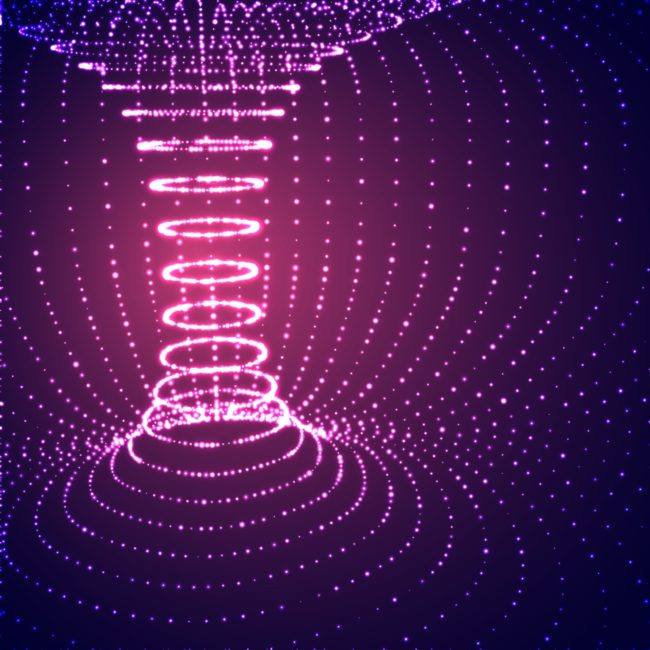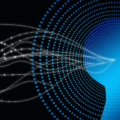In a world in which what we see is being rendered, traditional classifications get turned on their heads. How can we know what something is and how fast it is going at the same time, if how fast it is going is one way of rendering what it is? For this, we must consider the spin and scale of light.
The Spin of Things
In the previous two essays, we talked about the concept of light’s density or speed in the context of the holographic universe theory (here, here). We discussed how this might impact our interpretation of health and disease by giving us a new window on metabolism. Today, I would like to discuss a model that builds upon the idea of a holographic universe and suggest we make the speed of light a baseline for understanding other variables. Currently, we use matter and space as baseline characteristics to define objects.
Remember, the rock on the hill example from the first essay. When we see an object, like the rock on a hill, we treat it as one thing—matter that is at rest—but according to the holographic universe theory, what we see in 3D could be emerging from a 2D reality. I am treating the rock on a hill as two things: light that has acquired density, and acquired [potential] speed.
In other words, if ‘reality’ is 2D, there could be a variable we have not yet considered: holographic volume. My brain is rendering the 3D world. Is it rendering it at the proper scale? And if I don’t have the right Planck scale, will the new blood I make be the right size? Unfortunately, you cannot tell me, because you cannot see what I see. Even I cannot see what I see. I see only the images my brain composes. Some of the ideas in these essays are hypotheses that will have to be tested before we know if they hold any merit. This is not one of them. We understand very clearly how perception in the brain works. We simply have not applied the tenets of cognitive science to medicine.
If the Speed of Light Is the Baseline, Then What?
If the speed of light is the baseline, what is energy? Paradoxically, we can see “energy” as the speed required for matter to approach the speed of light from below. If the speed of light is the baseline, what is matter? Paradoxically, we can see “matter” as the density required for energy to approach the speed of light from above. In other words, matter’s acceleration is restricted by the speed of light, e.g. the sun, and energy’s deceleration is restricted by the speed of light—the moon. In sun and moon, we are visualizing the same boundary, from different sides.
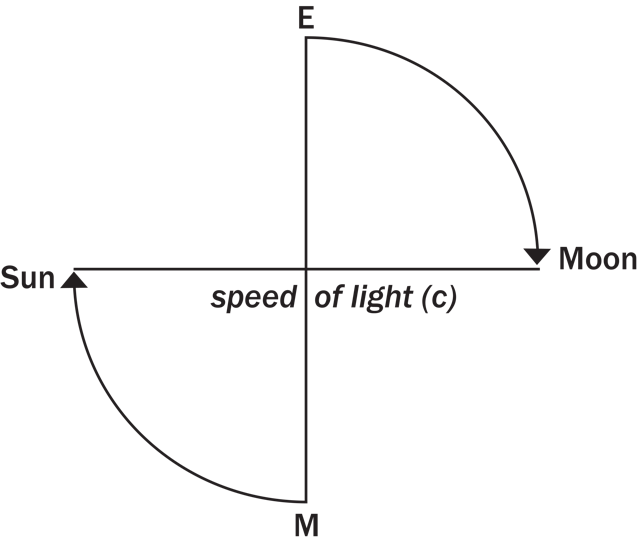
When we visualize from different hemispheres, it creates an important perceptual distinction. From M > sun, the direction of spin appears to be right > left (see above). From E > moon, the direction of spin appears to be left > right.
What if, when I am spinning right > left and the basal cells on my shoulder are spinning left > right, I have cancer. When I am spinning right > left and the H. pylori in my gut are spinning left > right, I have an H. pylori ‘infection’, and perhaps an ulcer. When I am spinning right > left and the DNA in my womb is spinning left > right, I am pregnant.
If I eclipse the speed of light, I can correct by increasing my density (vitamin K1). If I dip beneath the speed of light, I can correct by increasing my speed (vitamin K2).
The Unreasonable Effectiveness of Mathematics
The moon’s size is 27.27% of the earth’s size. The moon’s orbital period is 27.27 days. The sun is 400 times larger than the moon—and also 400 times farther away.
The black hole at the center of our galaxy, Sagittarius A*, has the largest angular size in the sky, followed by M87. M87’s black hole is 1000 times bigger, but roughly 1000 times farther away. —Feryal Özel, Harvard University Black Hole Initiative
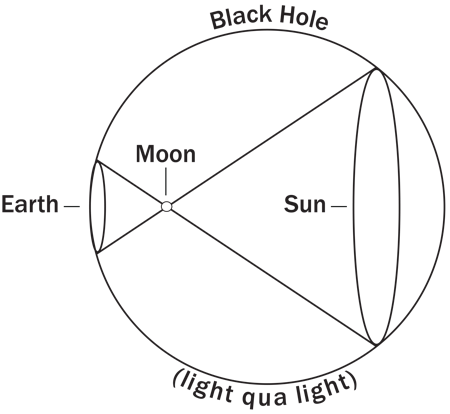
In these models, the earth is to the moon / as the sun is to the earth / as the black hole is to the sun. We are seeing the same relationship, the same equation, at different scales. Are our brains “filling in” (creating) the curvature we perceive? What if earth is the 2D plane between moon and sun? Or, with a shift of the scale, sun becomes the flat 2D plane.
Feeling My Limits
If I do not perceive flatness correctly, I have to deal with forces. If I am too dense—if I treat moon as the 2D plane—I will constantly battle the accelerating, expanding force (Parkinson’s?). If I am too diffuse—if I treat sun as the 2D plane—I will constantly battle the contracting force (ALS?). Only at the speed of light is light free to be itself.
In other words, we can never really depart from the baseline. If we eclipse the baseline, we “spin backward.” If we dip below the baseline, we “spin forward.” At my baseline, e.g. ~53 years old / female in menopause, I have begun to feel my limits. In order to spin forward, I have to first acquire density—and my density is already as high as it can be. In order to spin backward, I have to first acquire speed—and my speed is already as high as it can be. Light as light has limits. Its upper limit is c, and its lower limit is c. Any further acceleration or deceleration will result in a state change.
Cancer: A Metabolic Trap
What if the cancer cell’s metabolic rate is “burning and freezing” at the same time, and it finds itself metabolically trapped in precisely the same way I was? Recall from essay two, the energy factory in cancer cells spins backward relative to the other cells.
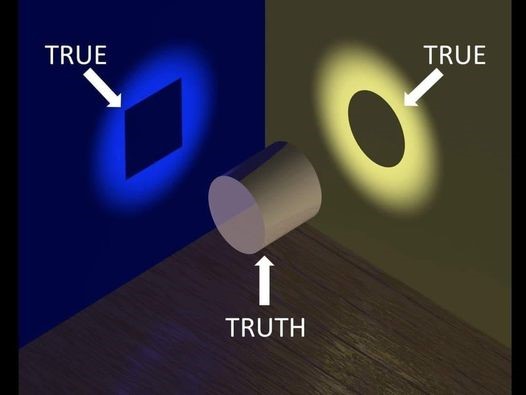
In a holographic model, we can account for the multi-directionality of spin because the playing field is not a vacuum. The playing field is dynamic. What I do depends on what I perceive the background to be doing, and what I perceive the background to be doing depends on my own constitution as much—actually, more—than any external “truth.” In a flat, 2D world, where what we perceive is the thing itself, and we do not have to consider the act of rendering, we do not have to account for spin. In a world that introduces time as a variable in health and disease, we do. This has implications for treatment.
With this model, we can consider forces, not just particles. For example, if I need to condense, I can use the magnetic force (iron). The presence of the magnetic force, however, will change the way I perceive the speed of light. If I need to expand, I can use “reverse-magnetism” (manganese). The presence of manganese will change the way I perceive the speed of light as well, albeit in the opposite direction. This adds a new level of complexity, for sure, but also, opportunity.
Seeing Through Colored Glasses
What is the pH of the instrument with which I am reading pH?
If I need to accelerate and expand, I can move sodium inside the cell—but then I will be reading the powers of hydrogen from an acidic perspective. If I need to decelerate and contract, I can move potassium outside the cell—but then I will be reading the powers of hydrogen from an alkaline perspective.
The same mineral, e.g. iron, can be used in different ways. When the background force is expanding, I use magnetism to hold myself together. When the background force is contracting, I use “reverse-magnetism” to hold myself apart.
Does this universe, my body, reach a tipping point—the speed of light?—where its polarity flips? What happens if some of the basal cells in my shoulder flip their polarity ahead of the rest of me?
When Matter Doesn’t Matter
When my father was dying of squamous cell carcinoma in 1995—one hundred years after the death of Louis Pasteur—his oncologist-prescribed multivitamins were clearly marked COPPER- and IRON-FREE. Copper facilitates electricity. Iron facilitates magnetism. We have assumed that the field is inertial, and we treat our minerals as inert. The holographic universe theory and these essays challenge that assumption.
From beneath light’s speed, we are viewing light as its passenger. From above light’s speed, we are viewing light as its track. Only at the speed of light are we able to see light as it is—the train as the train.
[O]ur observable universe is at the threshold of expanding faster than the speed of light. ―physicist Lawrence M. Krauss
I don’t want my pineal gland to be too cold and under too much pressure (matter). Conversely, I don’t want my pineal gland to be too hot and under too little pressure (energy). If the world is light, I want my pineal gland to be light.
If my perspective is limited to that of matter, no amount of acceleration is going to get me over the line. It is as if I am trapped behind the speed of light from below (ME/CFS, Chronic Fatigue Syndrome?). Similarly, if my perspective is limited to that of energy, no amount of deceleration is going to get me where I need to be. It is as if I am trapped above the speed of light (Autism?).
When light is too slow, time has to be too fast (ME/CFS). When light is too fast, time has to be too slow (Autism). We can never really depart from the baseline.
A Fresh Lens
To determine what time it is, my pineal gland reads the light in my environment. If it is wider than I am, I expand, by pulling sodium inside the cell. If it is denser than I am, I contract, by pushing potassium outside the cell.
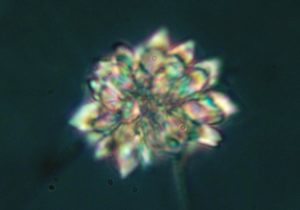
Since every cell in my body is intelligent, every cell reads the density of light for itself. If a cell or a cluster of cells within a local region contracts by a full degree of light’s speed, they pull back from the boundary and create a new “layer” of time—a fresh speed of light lens.
This fresh lens represents light’s limits, but at a smaller scale, which increases my constraints.
When my scale decreases, if the blood—and the oxygen and information it contains—is unable to reach me, I am forced to use another form of respiration: anaerobic (without oxygen). I try to manufacture new blood and new blood vessels (angiogenesis), but this takes time. Instead of being “under water,” it is as if I am “under light.” Starved of oxygen, I accelerate, but I can never really depart from the baseline. Each time I draw back, my density increases—and so does my perception of light’s speed.
I can try to slow down time—with radiation, with dopamine, with iron (magnetism), with hypo-methylating agents, such as the drug remdesivir—but, in a sense, I am only feeding the core dysfunction. In these models, to slow down time is to speed up light. From light’s perspective, I am freezing and scorching at the same time—but I am no longer seeing from light’s perspective. I am now seeing light through two lenses—one that is too small, and another that is too large.
From matter’s perspective, when I accelerate (vitamin K1, potassium grants permission), if I cross the speed of light lens, I split. From energy’s perspective, when I decelerate (vitamin K2, sodium grants permission), if I cross the speed of light lens, I fuse.
An Alternate Model
I would like to propose an alternate model to that of the vacuum. What we observe is taking place inside time. A unit of time has a fundamental length—27,729 days, which is about the length of a human life, and approximately 70 x 360 plus 7 x 360 days. This “width” of time defines a margin inside which, light is light. Above and below it, light is no longer light, but matter and energy, respectively.
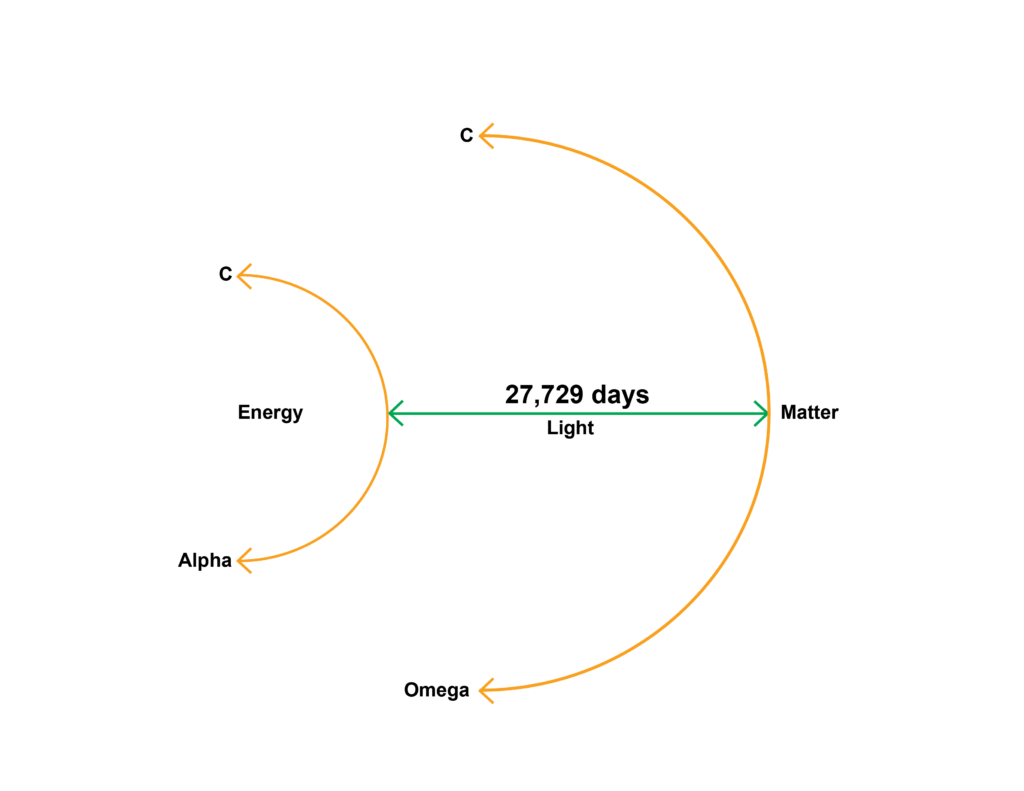
Between c and c, the field is inertial; I don’t have to deal with forces. Beneath the lower c—which I’m calling Alpha—if I perceive the exploding force, I will apply the condensing force, by moving potassium ions outside the cell. Here is the problem, though: if I am condensing, the world will appear to explode.
Above the higher c—which I’m calling Omega—if I perceive the condensing force, I will apply the exploding force, by moving sodium ions inside the cell. Again, a problem: if I am exploding, the world will appear to condense.
It is a metabolic cul-de-sac, a feedback loop. And its root cause, I believe, is relativity. Perception.
I am pushing calcium Ca+ ions back and forth across the cell membrane, but when time is too long, I have to push them too quickly. In this model, time is “long” (relatively speaking) when I am tall, or on top of a mountain. Time is “short” when I am deep-sea diving at the bottom of the ocean.
In other words, time relates to scale—and both relate to disease.
Seeing As Light Sees
Perhaps the speed of light functions like a lens. When observed from beneath the lens, light appears to be branching into many worlds. When observed from above the lens, light appears to be condensing into one. At the lens, light is light.
What happens if I insert a new lens—a fresh perspective, new consciousness, a stem cell—into an old environment? If I put new wine into old wineskins, I run the risk of re-setting the metronome. A new lens creates a new 2D plane from which light can condense and expand—or expand and condense. It creates a “fresh green,” if you will, from which can be derived fresh “blue yellow blue” or “yellow blue yellow.” New light is capable of operating at a different time signature—a different scale.
With cancer, I am deranged on both sides of time—both sides of the speed of light lens. To one side, I am too salty, too bitter. To the other, I am not salty enough. Instead of the flower, I become the fruit and the seed.
My light is spinning too quickly—and not quickly enough. To one side of time, it’s so cold, it’s burning up. To the other side, it’s so hot, it’s freezing. Instead of “earth,” I have become … sun and moon. Jupiter and Venus. Saturn and Mercury.

From beneath the lens, we see red and blue, splitting. From above the lens, we see red and blue, superimposed. But the truth is neither. The truth is red or blue. “Red and blue, splitting” and “red and blue, superimposed” are reciprocal illusions—noise. There was never really a purple rabbit. And there never really will be—for this one universe—both a red rabbit and a blue rabbit.
With chiral (splitting) images, the moments fly away too quickly (ME/CFS, Chronic Fatigue Syndrome?). With achiral (repeating) images, the moments linger too long (LSD, Autism?).
A New Frame Around an Old Problem
Contemporary physics, like medicine, has a fundamental problem. Both disciplines treat the world as physical and the observer as paramount, and both fail to successfully physicalize the observer. The holographic universe theory might solve that problem for physics. Could it influence medicine, too?
The universe is like a 2D plane—a flat sheet of paper. The observer is like a circle on the paper—a black hole. Time starts as a point and explodes outward, until it reaches the circle, and then beyond it. The observer can see light that is “smaller” than we are (inside the circle), and when light crosses the plane of the observer, we see darkness.
Darkness, in other words, is not darkness. It is light that is wider than light—wider than the light of the observer.
In these models, the speed of light is both Alpha and Omega—the end from which we start (Figure 5). It is the baseline or “dome” that we may observe from above, or below. From below, the dome appears concave, and we see “sun.” From above, it emerges—gradually—as convex.
A universe is one house. We see through a glass darkly—partially. When we see the sun, we are blind to the dark-matter moon around it. When we see the moon, we are blind to the dark-energy sun within it. We see what we see, not what we are.
If we incorporate time into our calculations, illness can be re-envisioned as metabolic. Both backward and forward directions of spin are available to us. It all depends on the relative density of the observer—whether we are seeing light from matter’s perspective (forward spin) or energy’s perspective (backward spin). Light “spinning backward” should be investigated further for a possible role in oncogenesis, pathogenesis, and embryogenesis.
We Need Your Help
More people than ever are reading Hormones Matter, a testament to the need for independent voices in health and medicine. We are not funded and accept limited advertising. Unlike many health sites, we don’t force you to purchase a subscription. We believe health information should be open to all. If you read Hormones Matter, and like it, please help support it. Contribute now.
Yes, I would like to support Hormones Matter.
Feature image purchased from Shutterstock.
